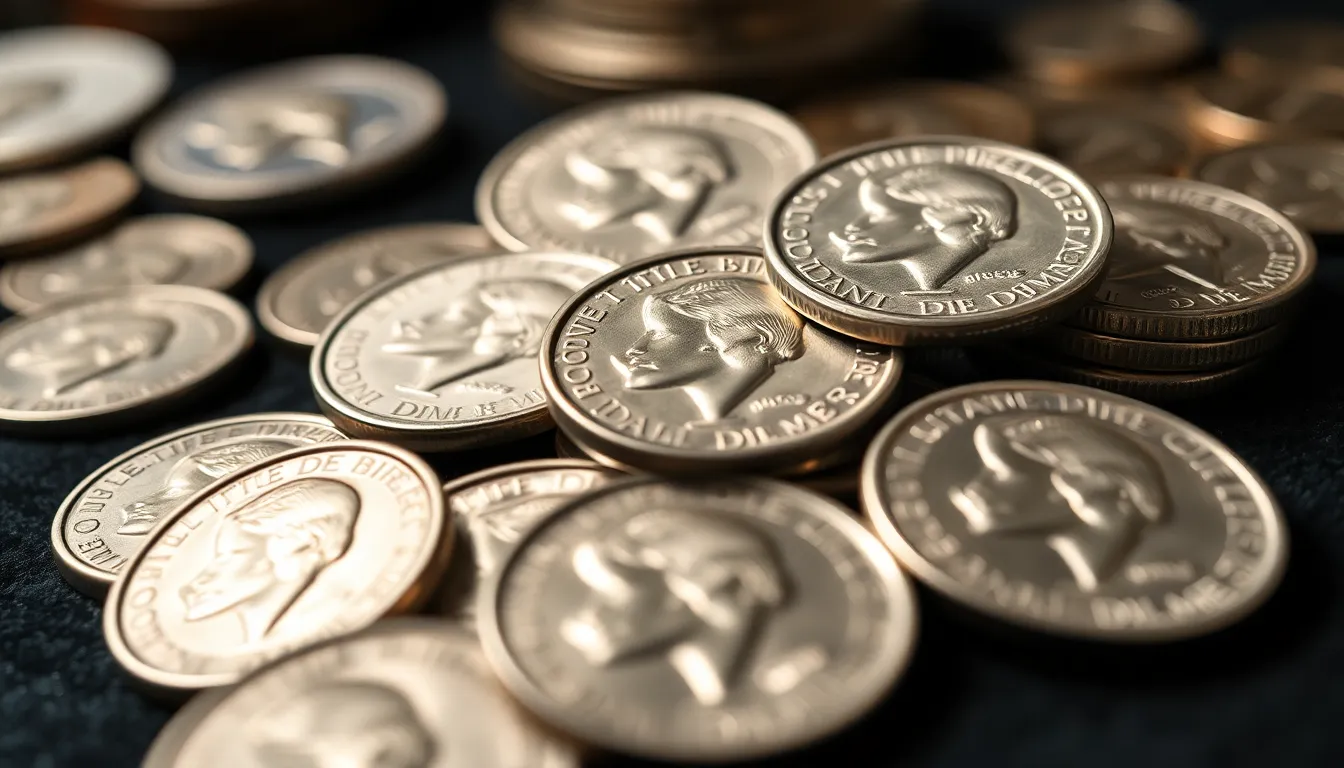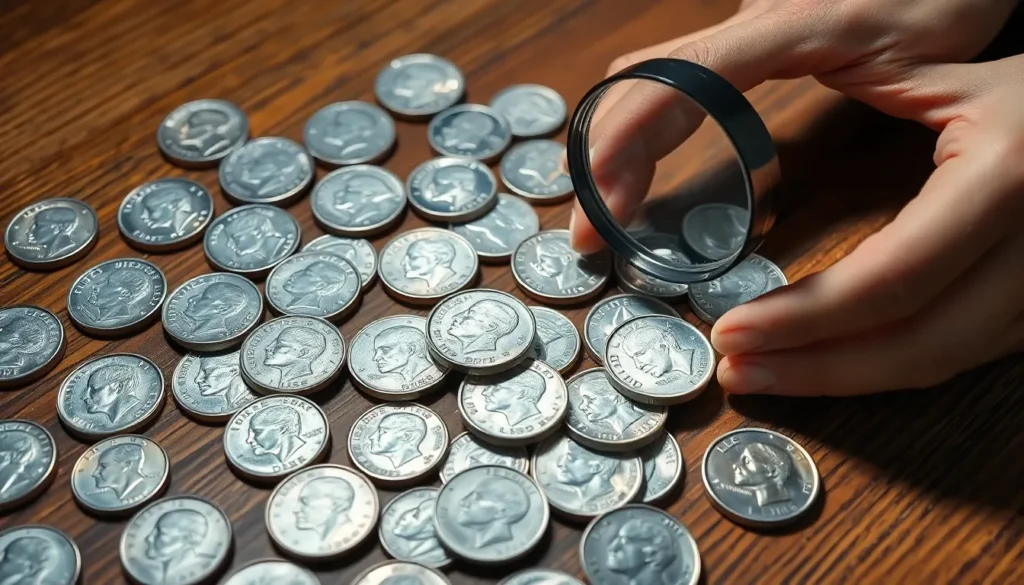Table of Contents
ToggleDimes might seem like pocket change, but some modern ones are worth more than a cup of coffee—or even a fancy latte! While most folks toss them into jars or lose them under couch cushions, savvy collectors know that certain dimes can pack a surprising financial punch. Who knew that a tiny coin could turn into a treasure hunt?
Understanding Modern Dimes
Modern dimes hold more potential value than many realize. Certain issues and varieties can command impressive prices in the collectors’ market.
Definition and History
Dimes, a denomination of U.S. currency, represent ten cents. Introduced in 1796, their design has changed significantly over time. Historically, dimes featured silver content before transitioning to copper-nickel alloy in 1965. Collectors often seek well-preserved examples from various years, as age and condition heavily influence value. Various series exist, especially since the 20th century when specialized designs stimulated collector interest. Understanding the historical context enriches the appreciation for these coins.
Types of Modern Dimes
Several types of modern dimes possess notable value variants. First, the Roosevelt dime, minted since 1946, features Franklin D. Roosevelt on the obverse. Specifically, particular dates and mint marks can bring substantial premiums. Second, special editions such as the 1976 bicentennial dimes attract collectors due to unique designs. Additionally, error coins, including those with misprints, often fetch high prices. Lastly, the 1996-W Roosevelt dime, a limited release, exemplifies a type that’s highly sought after in gem condition. Each type contributes to an expanding market for collectors eager to uncover hidden treasures.
Factors That Determine Value

Several elements affect the value of modern dimes. Evaluating mint marks and overall condition plays a crucial role in determining their worth.
Mint Marks and Rarity
Mint marks indicate where a coin was produced, influencing its rarity and value. Generally, dimes with rare mint marks attract higher prices in the collectors’ market. For example, the 1996-W Roosevelt dime is significantly rarer compared to its 1996-P and 1996-D counterparts. Significant differences exist between coins minted in Philadelphia, Denver, and West Point. Collectors often prioritize mint marks that denote lower production numbers. High demand for specific varieties increases their market value, making rarity a key consideration for collectors.
Condition and Grade
Condition and grade significantly influence a coin’s worth. Coins in uncirculated condition typically fetch higher prices than those showing signs of wear. Grading standards, including the Sheldon scale, provide guidelines for assessing a coin’s quality. Collectors examine surface marks, luster, and overall eye appeal when determining grade. High-grade examples often command a premium due to their limited availability. Coins exhibiting minimal wear, scratches, or blemishes rank higher in value. The importance of well-preserved specimens cannot be overstated, as they hold greater appeal to serious collectors.
Notable Modern Dime Varieties
Modern dimes exhibit several notable varieties that attract collectors. Each variety possesses unique characteristics that influence its market value.
Silver Dimes
Silver dimes produced before 1965 include many desirable examples. These coins contain 90% silver, making them more valuable than the current face value. Key dates, such as the 1964 and earlier Liberty and Roosevelt dimes, often command higher prices due to their silver content. Market demand significantly drives the value of these coins. For instance, prices for uncirculated 1964 dimes may reach $2 or more based on condition and demand. Collectors frequently seek out pristine examples, as mint condition impacts worth considerably.
Special Editions
Special edition dimes also hold substantial collector interest. The 1976 bicentennial dimes, for example, feature unique design elements that capture buyer attention. These coins commemorate the United States’ 200th anniversary and are sought after by enthusiasts. The 1996-W Roosevelt dime, minted in West Point, remains one of the rarest modern dimes. Prices for this dime can exceed $1,000 in excellent condition. Other special editions may include commemorative issues that attract niche collectors. Overall, unique characteristics significantly enhance the desirability and value of these special dimes.
Collecting Modern Dimes
Collecting modern dimes offers an intriguing opportunity for numismatists and casual enthusiasts alike. Many coins serve as captivating financial assets waiting to be discovered.
Tips for New Collectors
Researching is crucial for novice collectors. Understanding mint marks helps identify the coin’s origin, which can influence its value. Prioritize condition by examining each coin carefully, as uncirculated examples fetch higher prices. Joining online communities or local clubs provides valuable insights and networking opportunities. Engaging with fellow collectors fosters knowledge sharing and tips on identifying rare finds. Setting a budget ensures a focused approach while exploring the market.
Where to Buy and Sell
Local coin shops often serve as excellent starting points for new collectors. Additionally, reputable online marketplaces facilitate the buying and selling of modern dimes. Websites like eBay showcase a broad range of available coins along with their selling prices. Auctions present opportunities to acquire unique coins or sell duplicates found in collections. Networking with other collectors can lead to private sales that yield better deals. Always verify the seller’s credibility to avoid counterfeits or misrepresented items.
Modern dimes hold a treasure trove of value that many overlook. As collectors delve into the world of dimes they often find unexpected gems that can significantly boost their collections and investments. The allure of unique mint marks and exceptional condition makes these coins not just currency but valuable assets.
Whether it’s the rare 1996-W Roosevelt dime or special editions like the 1976 bicentennial dimes collectors are constantly on the lookout for these hidden treasures. With the right knowledge and resources anyone can embark on an exciting journey through the fascinating realm of modern dimes. The potential for profit and enjoyment in this hobby is immense, making it a rewarding pursuit for both seasoned numismatists and newcomers alike.




